Learn how to make classic, authentic lasagna Bolognese with my master fresh pasta dough recipe, homemade ragù, step-by-step instructions and plenty of detailed tips. I’ve also included make-ahead options to store and freeze.
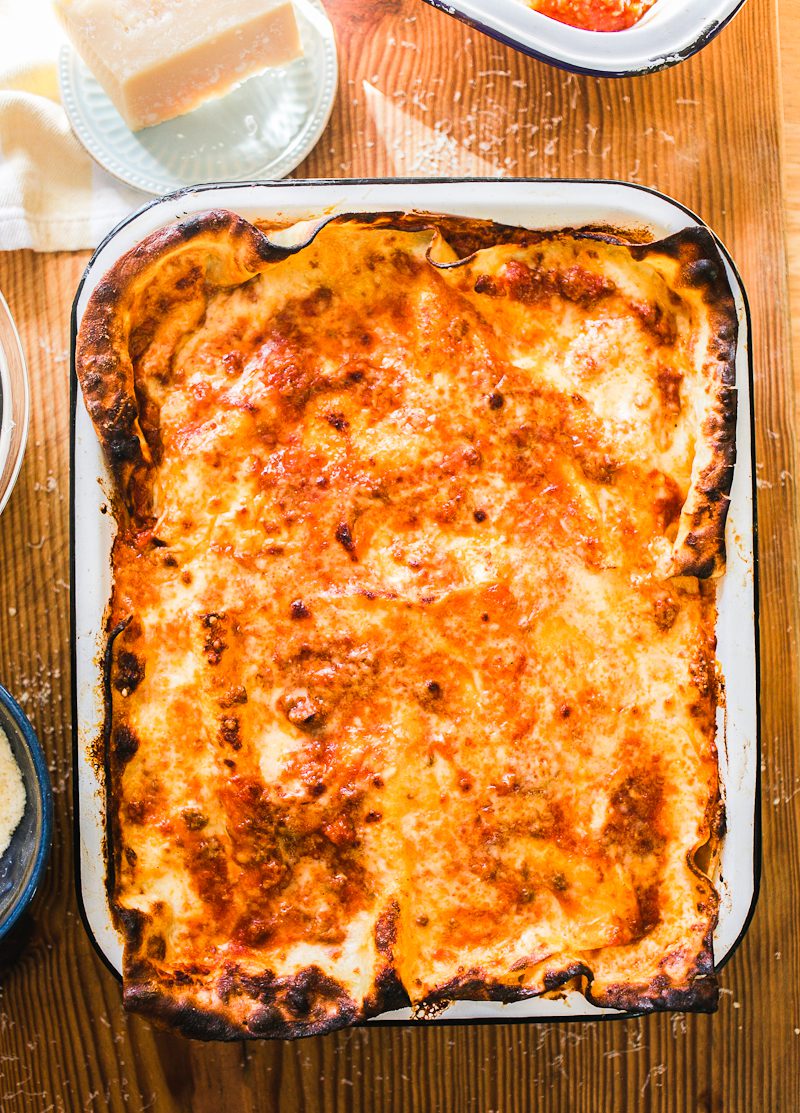
Imagine layers of fresh homemade pasta with ragù Bolognese, creamy béchamel sauce and Parmesan cheese baked to bubbly, golden perfection in a 9×13-inch pan! This is lasagna Bolognese, a experience unto itself, one that words cannot possibly describe. I’ve tested this recipe nearly 100 times, taking care to develop each and every component, finally perfecting this iconic culinary classic with pride! And it tastes darn good.
What To Expect
In this post, you’ll learn how to make my classic lasagna Bolognese with step-by-step instructions, make-ahead tips, storage options, freezing instructions and a sample cooking timeline to plan for success. Make no mistake: lasagna is a labor of love. However, once you master the process you’ll quickly become a lasagna pro.
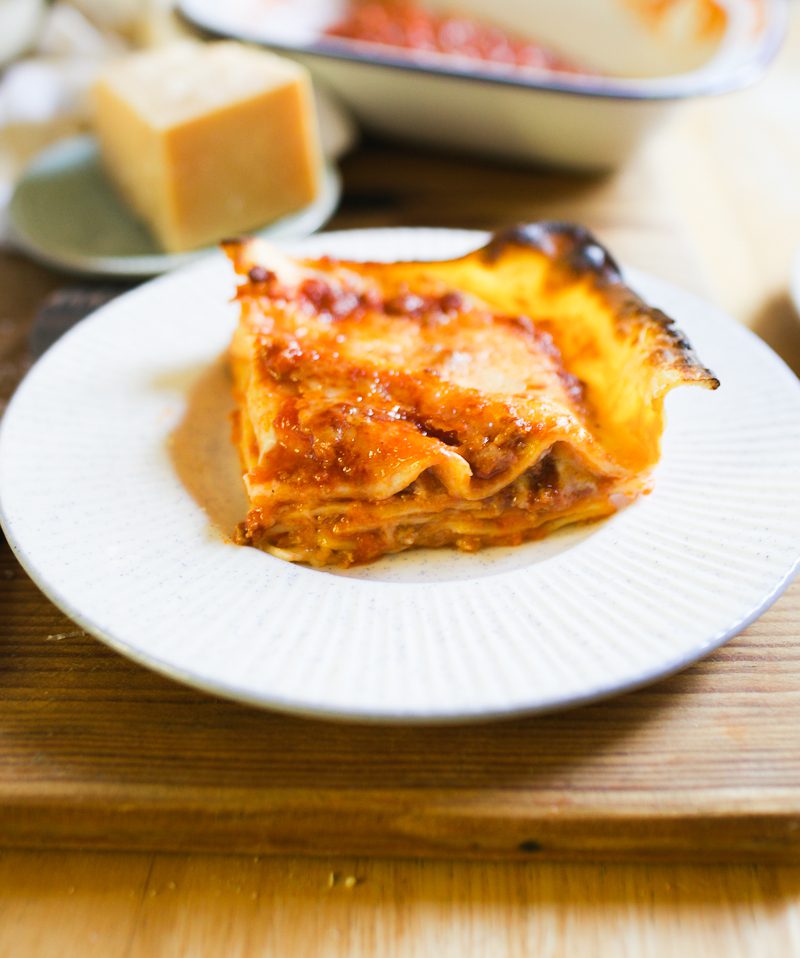
What Is Lasagna Bolognese?
First, let me tell you what it’s not. It’s not the “Italian-American style” lasagna (rooted in southern Italy, fyi) with boxed lasagna noodles, meat sauce, creamy ricotta, and mozzarella cheese. Lasagna Bolognese hails from Northern Italy, featuring 4 similar, but different layered components: fresh lasagna noodles, ragú Bolognese, béchamel sauce (creamy white sauce) and Parmesan cheese. Traditionally, lasagna Bolognese is made with fresh spinach pasta, but regular fresh pasta can be used too.
It’s All In The Sauce
To truly nail this recipe, you need to nail the main sauce. The taste of ragù Bolognese is paramount. It’s rich, thick, and absolutely delicious. Additionally, it contains milk, meat stock, white wine, bay leaves and nutmeg. Get to know the subtle nuances of this spectacular ragù, perhaps as a stand alone dinner with fresh homemade pasta, and you’ll understand why this lasagna tastes like no other.
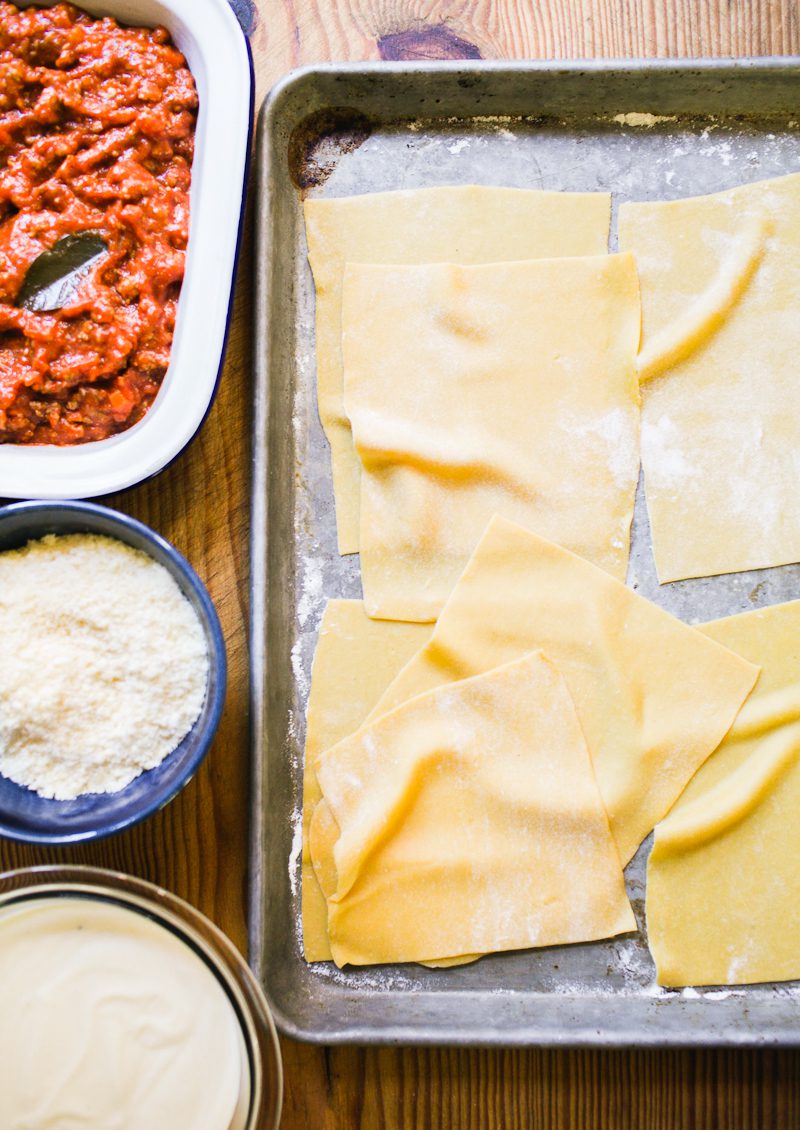
Lasagna Bolognese Ingredients You Will Need {4 components}
- Homemade Lasagna Noodles
- Ragù Bolognese Sauce
- Creamy Béchamel Sauce
- Parmesan Cheese
How To Make Lasagna Bolognese {Step-By-Step Instructions}
First, let me say this: I never, ever make and eat lasagna on the same day. It’s a project. There are too many steps to cram into one day. With that said, each of the 4 components listed above can be made in advance and used when ready to assemble (see sample timeline). I highly recommend doing this. Additionally, you’ll need ample space to spread out and work- no exceptions! With that in mind, let’s proceed.
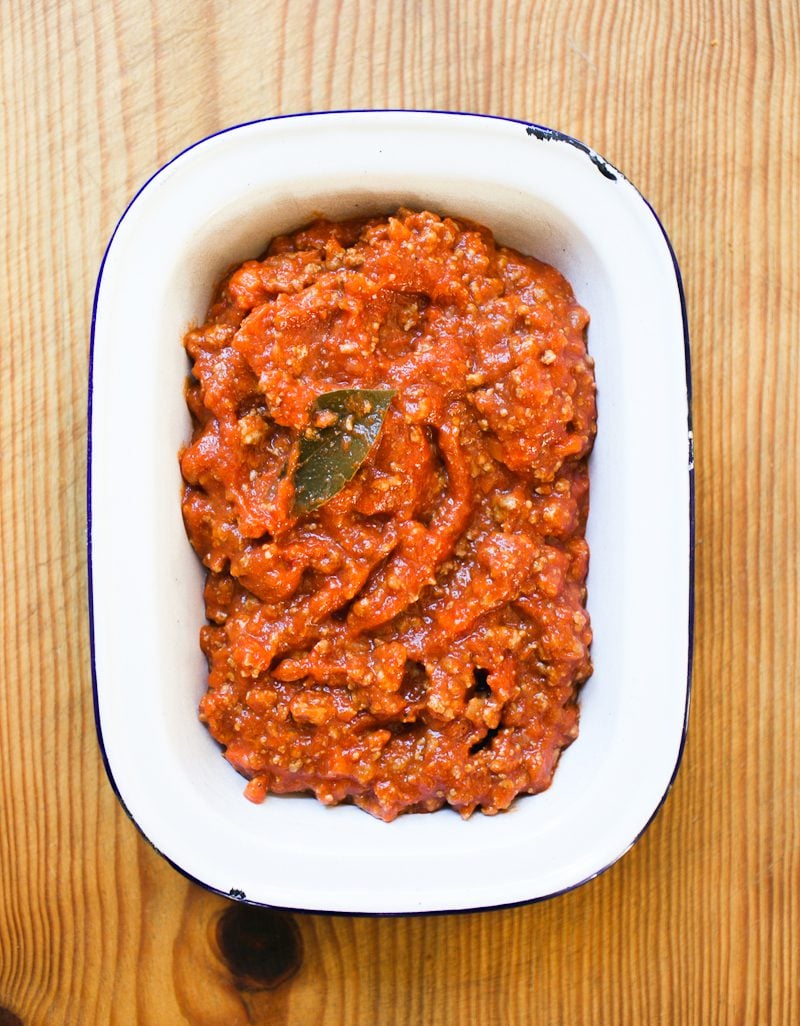
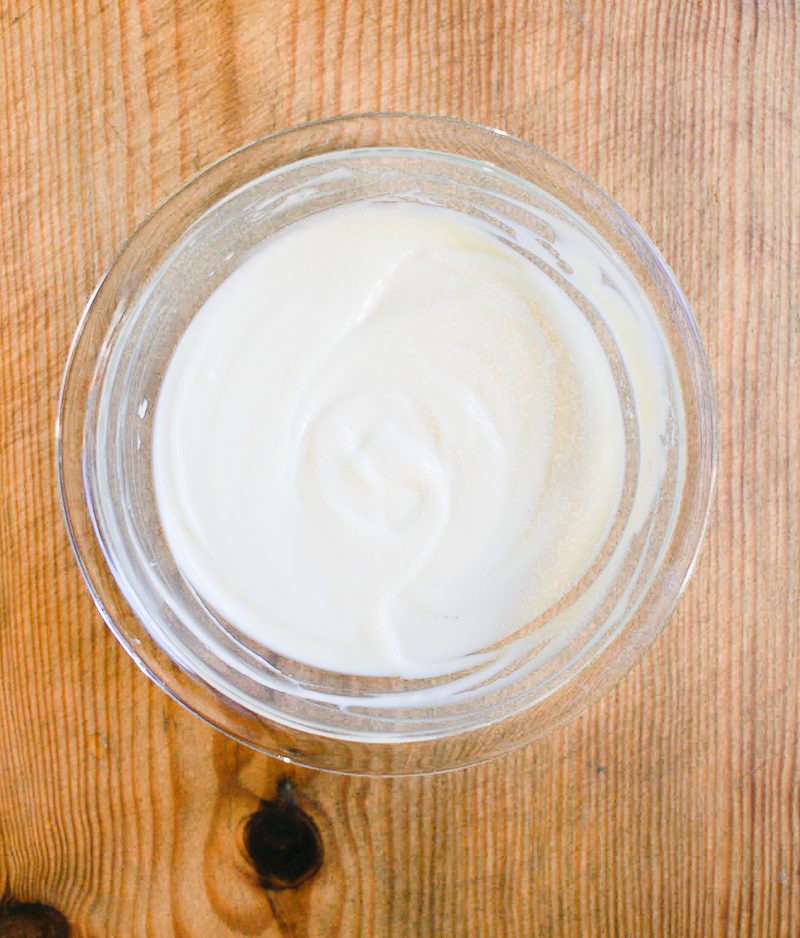
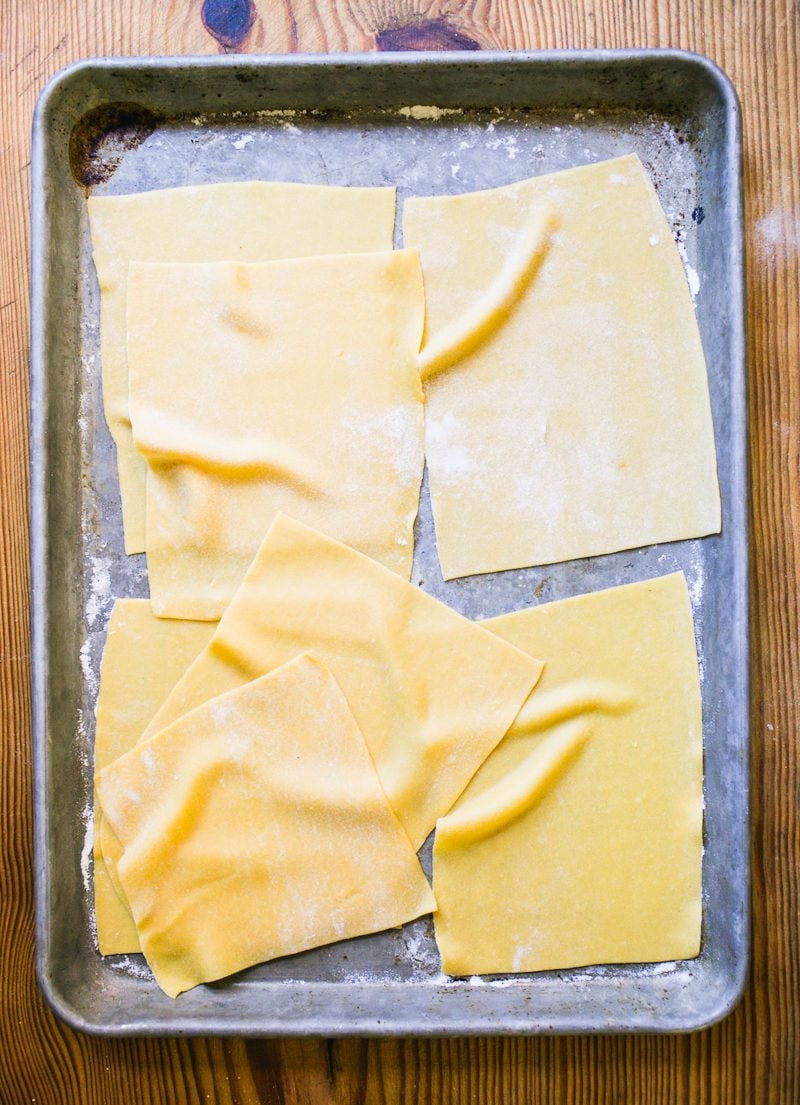
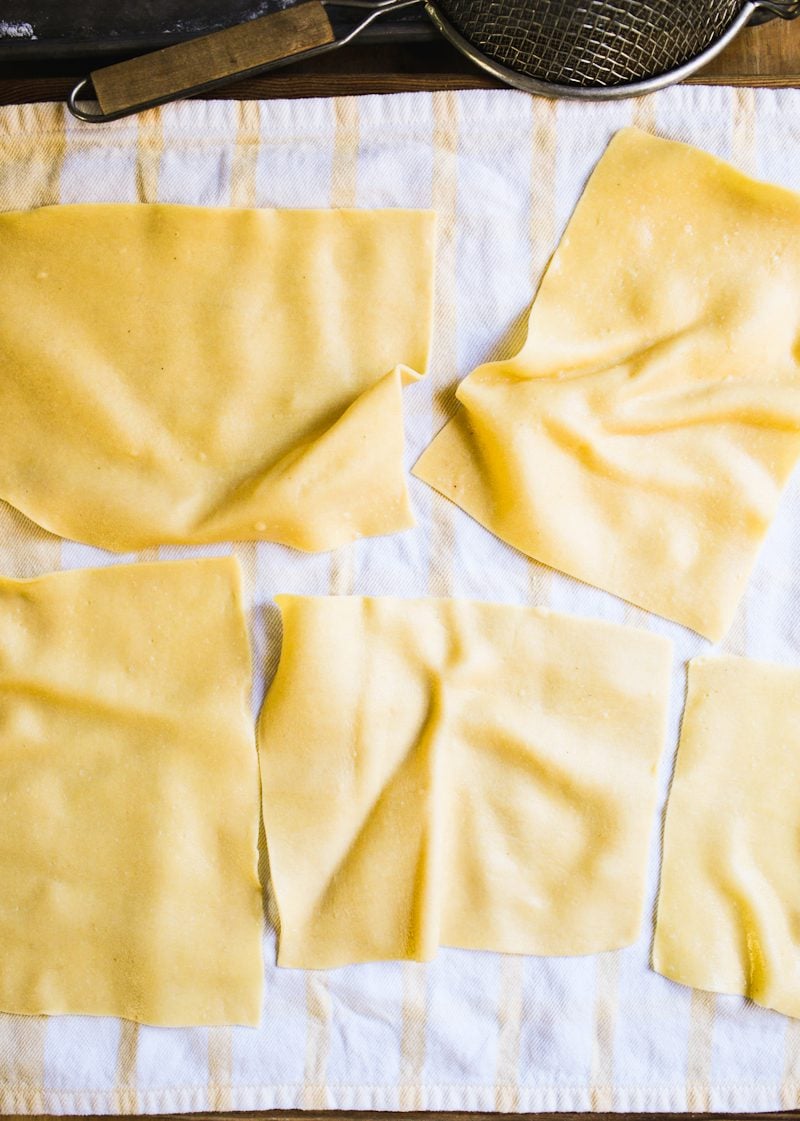
Step #1: Prepare The Components
- Make The Ragù Bolognese Sauce: Can be chilled up to 3 days, or frozen up to 3 months. Note: Choose good quality meat stock, such as bone broth, which contains natural gelatin. Gelatin adds viscosity to the ragù. This helps the sauce “stand up” in between the layers of pasta. I use Trader Joe’s organic chicken bone broth found in the refrigerator section.
- Make The Béchamel Sauce: Can be chilled up to 3 days, or frozen up to 1 month. Béchamel sauce thickens as it cools, especially when stored in the fridge. Give it a good mix before using. It will be easier to spread.
- Make The Pasta: Roll the pasta dough into sheets, approximately .60 mm thick (#4 setting on the KitchenAid pasta roller attachment). Then cut the sheets into lasagna noodles to fit a 9×13-inch baking pan. Save any scraps to make additional layers.
- Parboil The Lasagna Noodles: Bring 4 quarts of water to a boil; season with 1 tbsp. fine sea salt. Add one lasagna noodle, possibly two, and wait until it floats. Boil for only 30 seconds. Remove with a small strainer and plunge into an ice bath to rinse off the sticky starch. Dry on clean kitchen towels. Note: This step seasons the pasta with salt (you don’t want bland pasta) and creates rumply-looking lasagna noodles which adds height and interest to the finished dish.
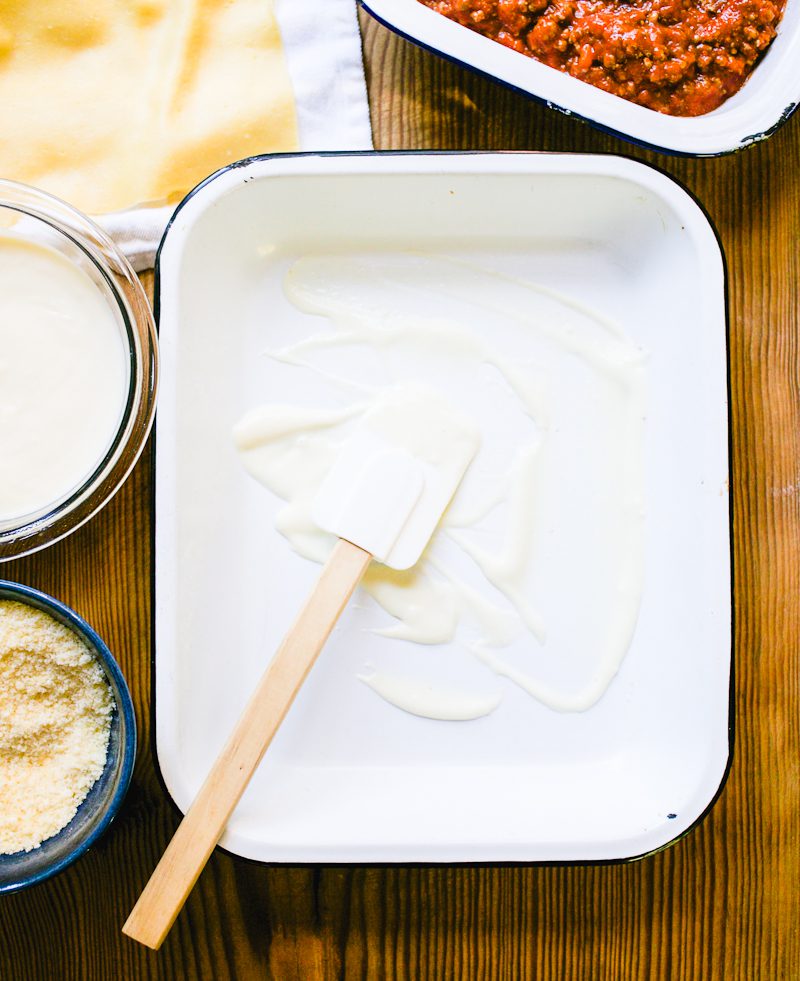
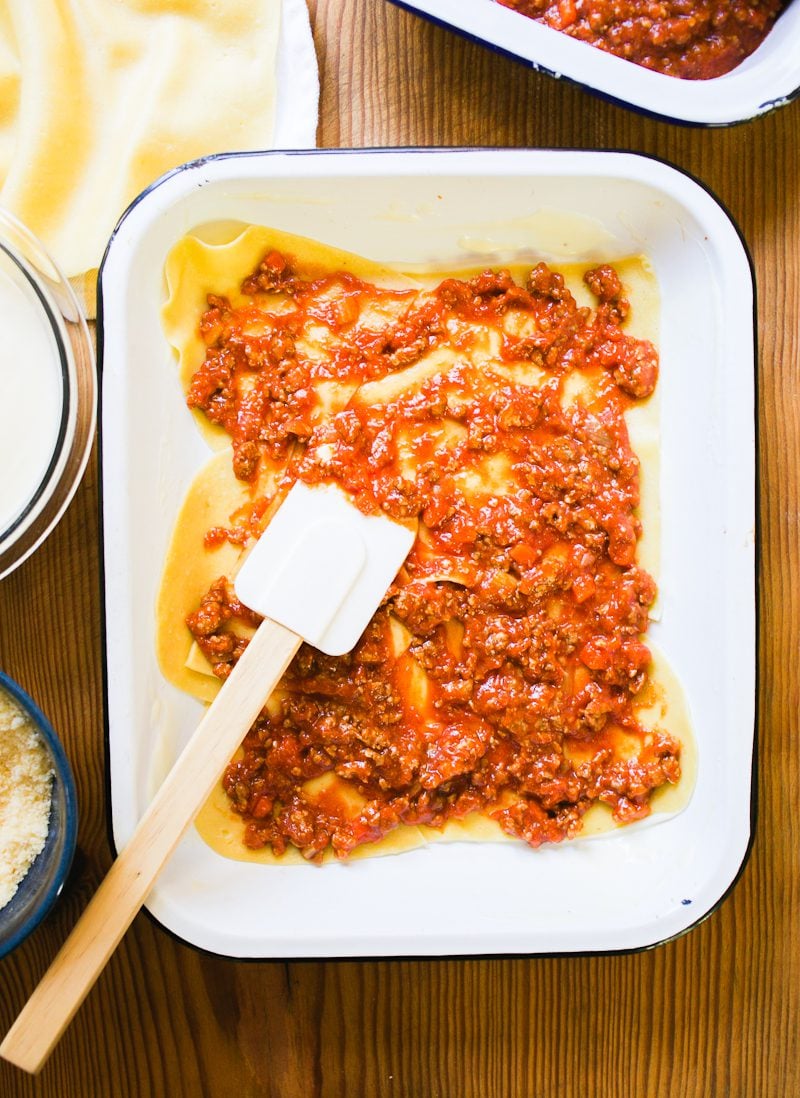
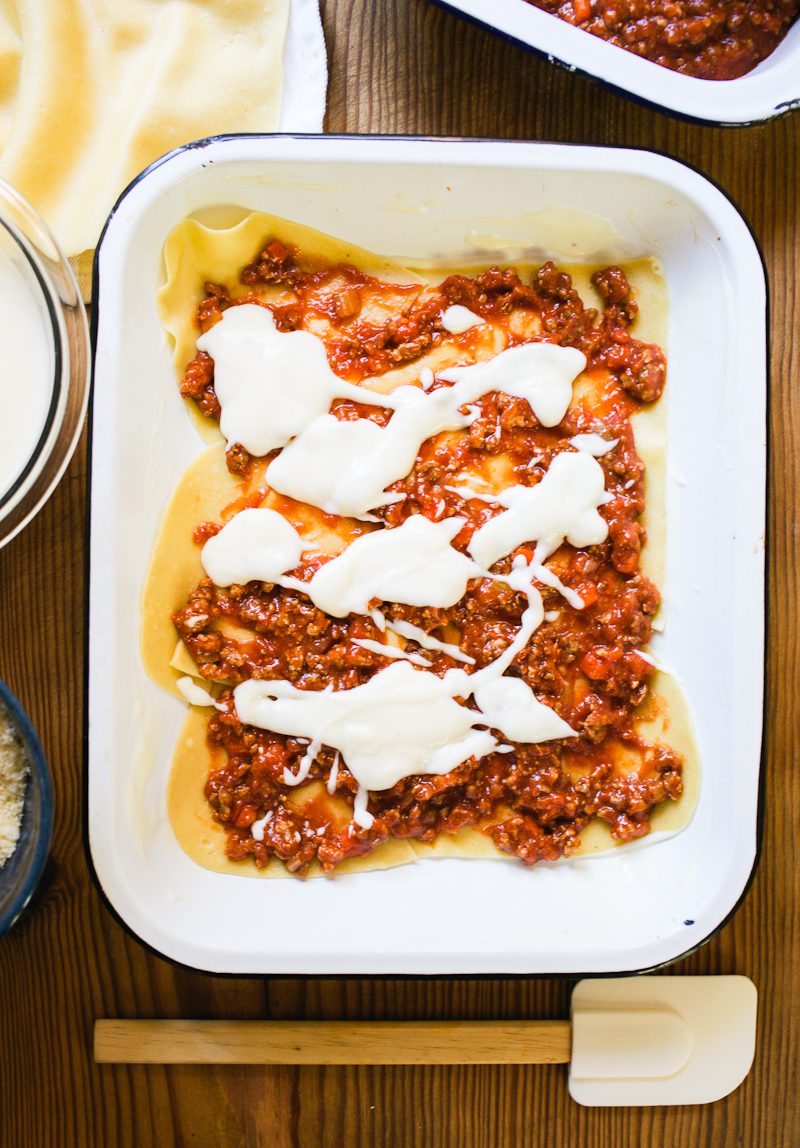
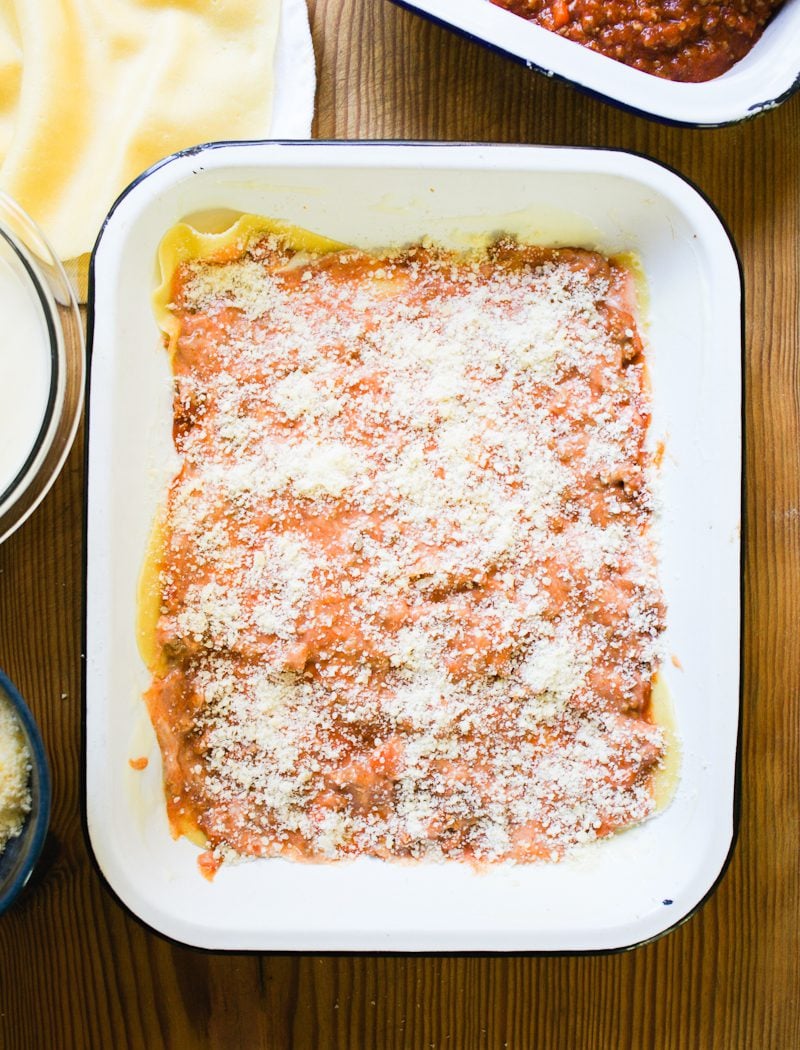
Step #2: Layer & Assmemble The Lasagna
- Note: Before you begin, make sure your ragù is at room temperature (NOT HOT). Otherwise it will soak into the noodles prematurely. If you’ve made the ragù ahead of time, and it’s cold from the fridge, warm it slightly so that it’s spreadable. For the béchamel sauce, I prefer using it slightly chilled- it’s easier to spread. Remove from the fridge and transfer to a bowl; mix really well. The texture will look like runny sour cream.
- Spread 1/4 cup béchamel sauce on the bottom and sides of a 9×13-inch baking pan. Use a rubber spatula to spread it out. Lay (2) lasagna sheets on top, slightly overlapping.
- Top with 1 cup ragù, spreading it all the way to the corner and sides.
- Add 1/2 cup béchamel on top of the ragù; thoroughly mix the sauces together. It should look pink in color and messy.
- Finally, top with a generous handful of ground Parmesan cheese, about 1/4 cup .
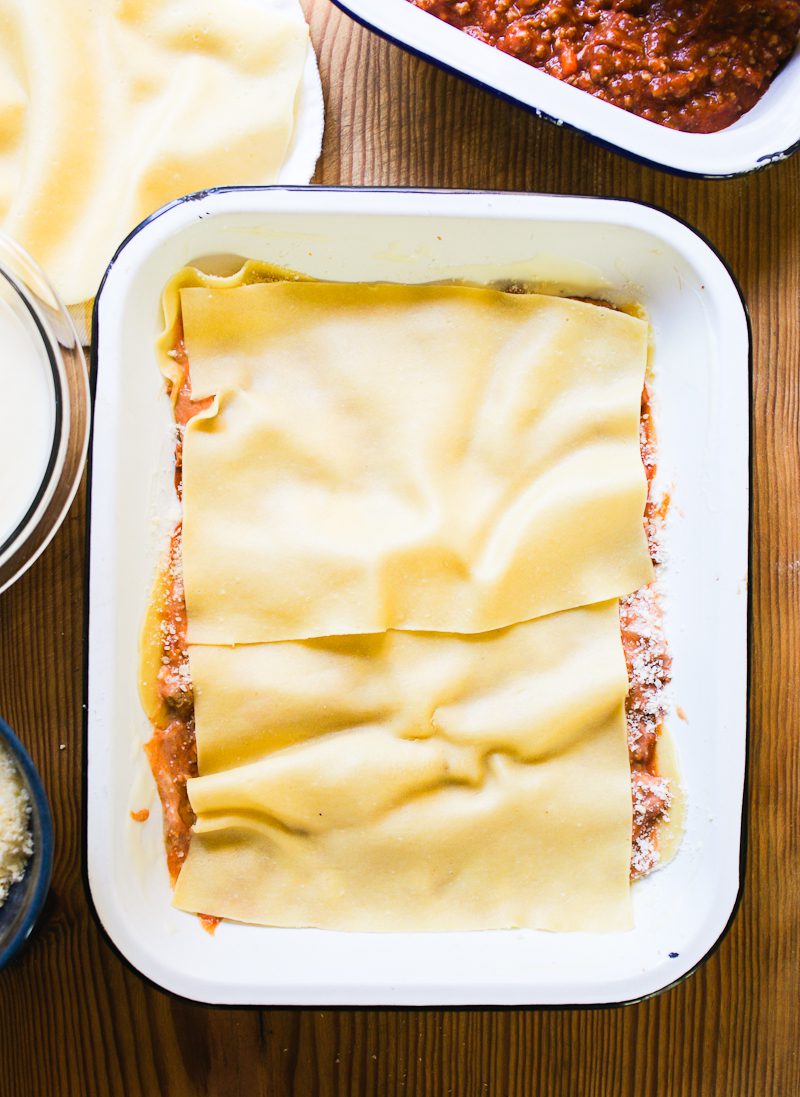
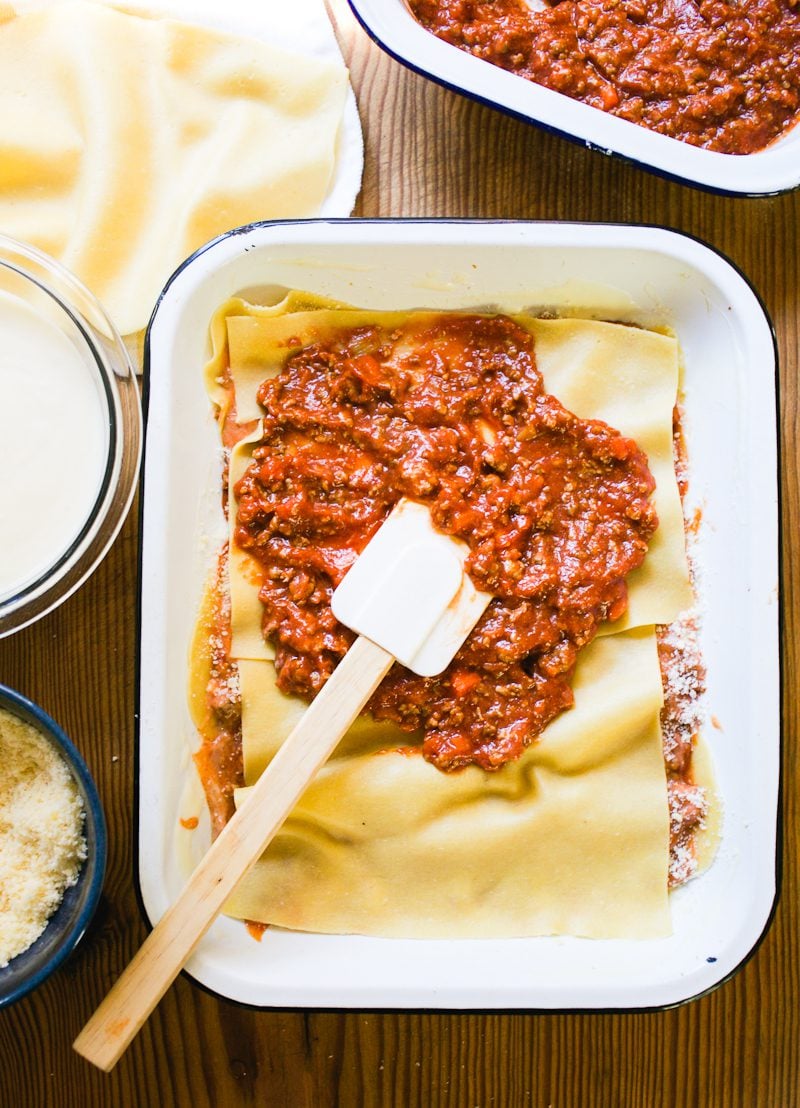
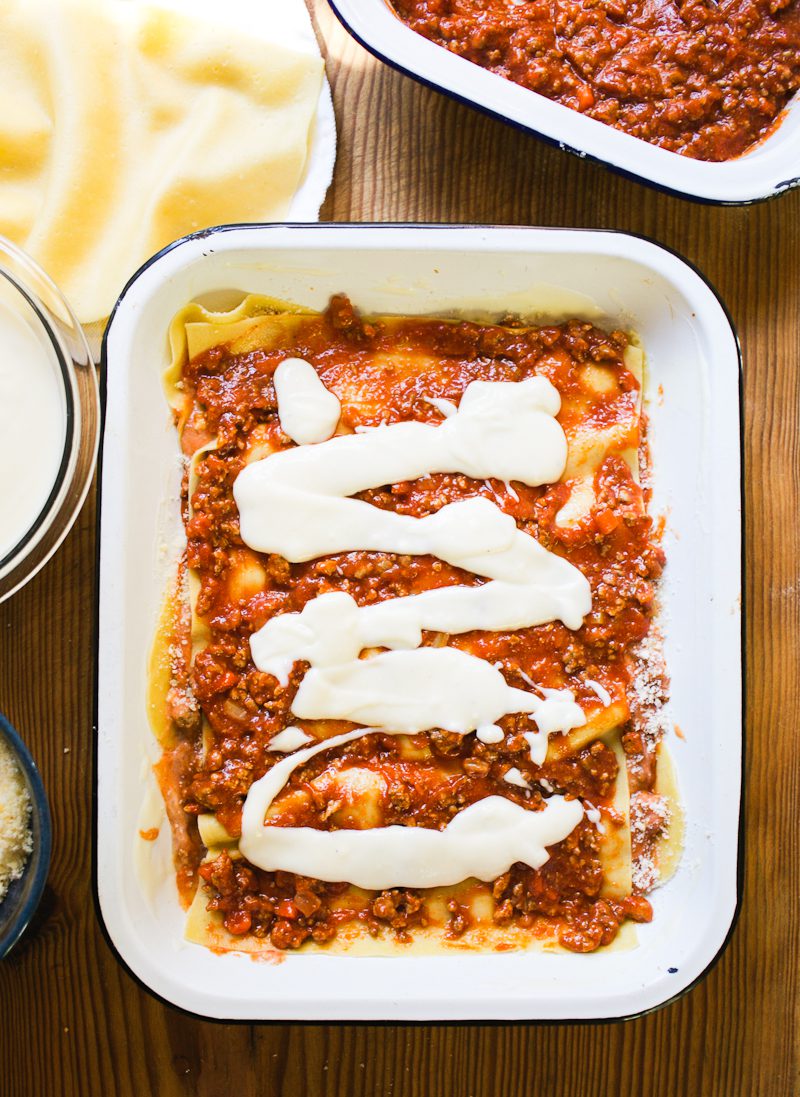
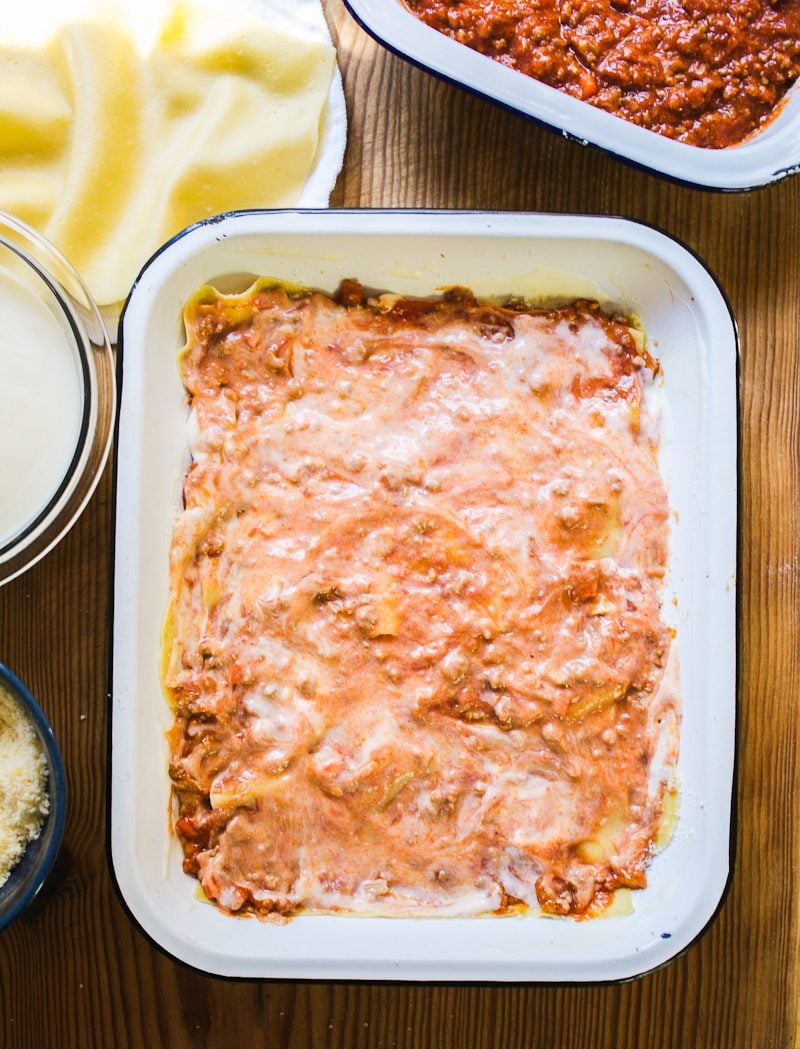
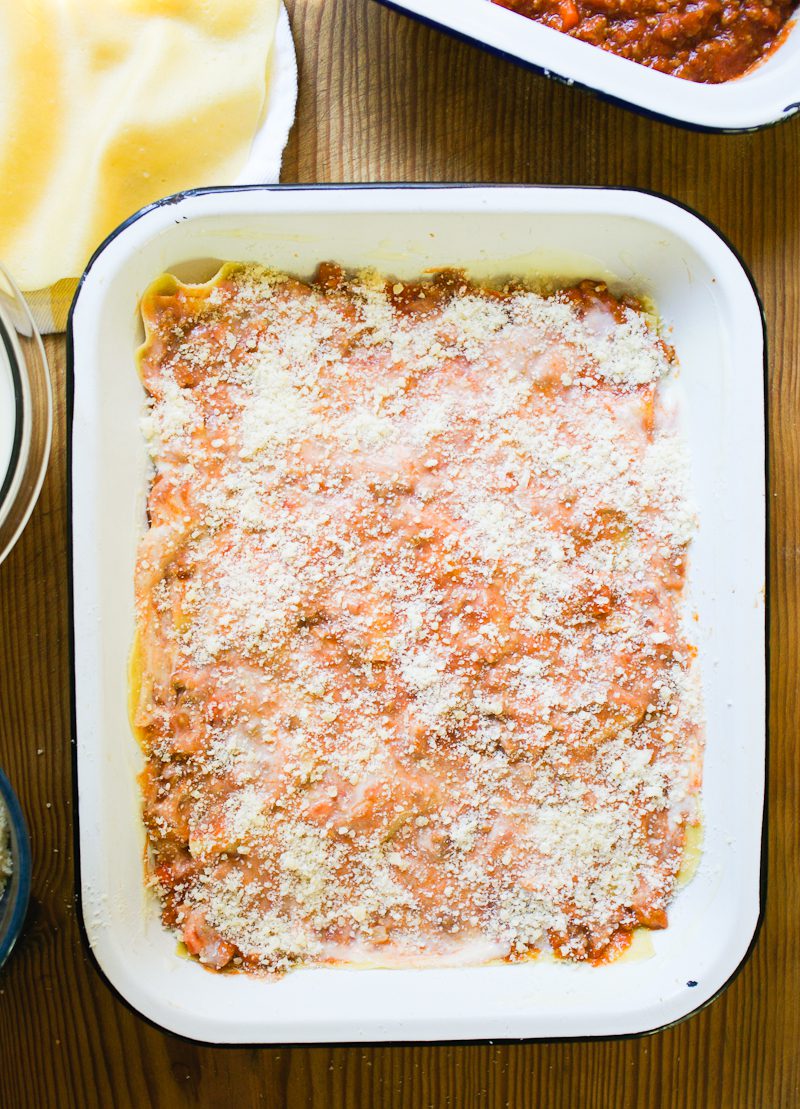
Assemble & Layer The Lasagna {con’t}
- Repeat the layering process (ragù, béchamel & Parmesan cheese) until you get to the last layer of pasta. At this point, top the last layer with 1/2 cup béchamel sauce first, and only a few dollops of ragù for color. Swirl together. Top with plenty of Parmesan cheese- don’t be shy. You should end up with 5-6 layers of lasagna depending on how thin you rolled that pasta sheets.
Step #3: Bake The Lasagna
- Cover the lasagna with foil. Bake @ 350 F for 30 minutes or until heated through.
- Remove the foil and broil until bubbly and golden brown. Keep your eye on it.
- When finished, rest for at least 25-30 minutes before slicing. The lasagna is super hot and needs to set.
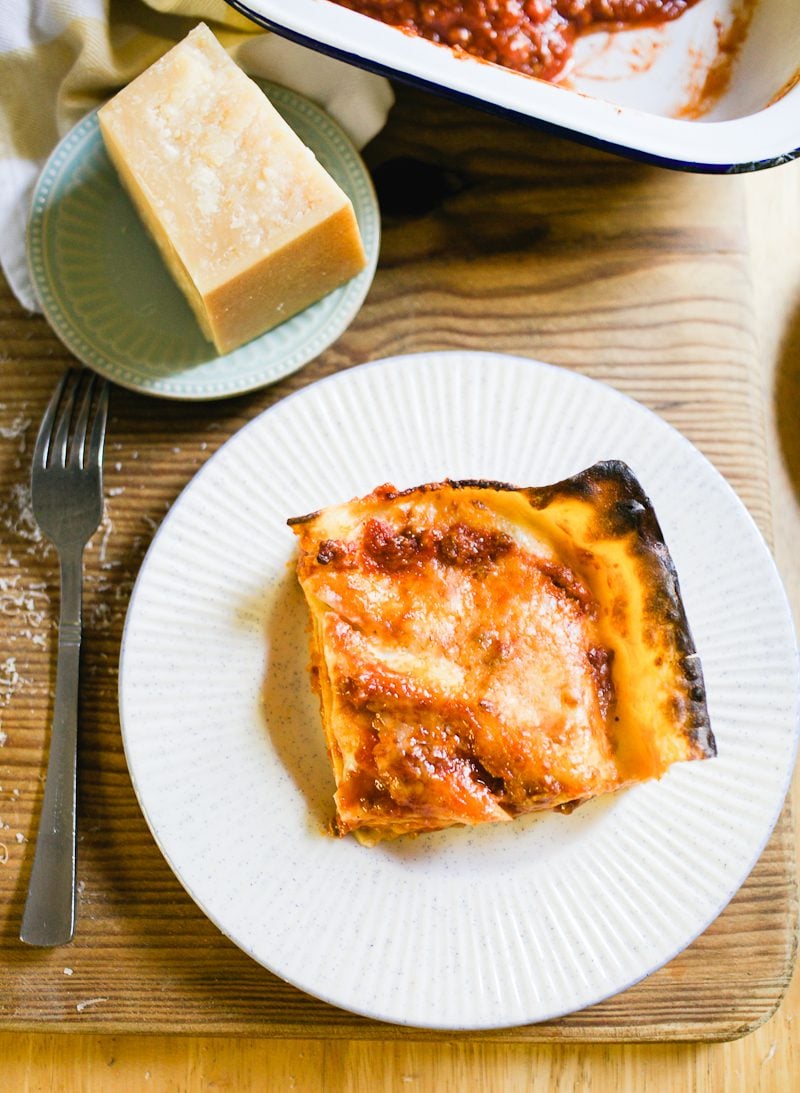
Lasagna Bolognese Tips
- All sauces can be made (and frozen) in advance. Store in the refrigerator for up to 3 days, or in the freezer for 1-3 months.
- Always use room temperature sauce (NOT HOT).
- Use a rubber spatula to easily spread the sauces.
- Make sure to cover the edges and sides of the lasagna with sauce. It tends to pool in the center.
- Mix the ragù and béchamel sauce together thoroughly. It should look pink and messy. Do not overthink this. Just mix. FYI: mixing the sauces together is my personal preference; some people do not mix at all. They layer. For me, the binding power of béchamel sauce gives the ragù extra body and viscosity when mixed together.
- Be strategic when layering. Use the “scrappy-looking” lasagna noodles on the bottom or in a middle layer somewhere. No one will notice. Plus, I always end up with an extra layer when using the leftover scraps. For the top layer, use the rumpled lasagna noodles for added texture and height.
- Reheat leftover lasagna as individual cut slices (not the whole tray). Place cut slices onto a parchment lined baking sheet. Make sure they’re not touching. Bake @ 350 F until warmed through. The edges and sides will get all crispy and delicious! Serve with extra sauce if you have any (feel free to combine the ragù and béchamel sauce together).
- When troubleshooting lasagna, look at it holistically. Meaning, each step is connected to the next. If you make any changes to the recipe, the final result will change too. For example, if you use a larger pan, you’ll have less layers. If you decide to roll your pasta sheets thinner than the indicated thickness, you’ll need to decrease the parboil time and possibly use less sauce/layer to account for the delicate texture of the pasta sheet.
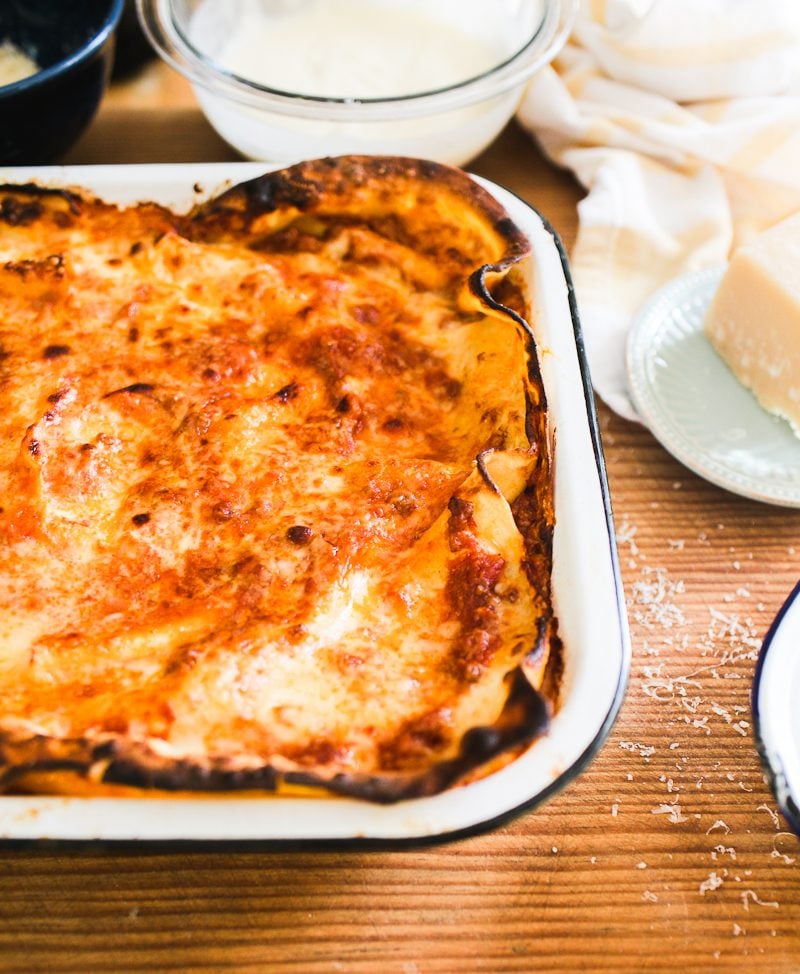
Storage Options
- How To Freeze Lasagna: Layer and assemble the lasagna in a 9×13-inch freezer safe baking pan or foil tin. Place a layer of parchment paper on top (this protects the surface from condensation dripping on the surface when defrosting). Wrap in several layers of plastic wrap, then foil. Freeze up to 1 month. Defrost overnight in the refrigerator. Remove from the refrigerator 1 hour prior to baking.
- How To Store Lasagna In the Refrigerator (Make-Ahead): Layer and assemble the lasagna in a 9×13-inch baking pan. Cover with foil. Chill up to 1 day. Remove from the refrigerator 1 hour prior to baking.
Sample Cooking Timeline
- Day 1: Sauce Day (3+ hrs, including simmering time). Make the ragù. While it’s simmering, make the béchamel sauce. Both sauces can be chilled up to 3 days, or frozen up to 3 months. PS: I always treat myself to take-out on “sauce day” so dinner is one less thing I have to think about (and clean up).
- Day 2: Pasta Day (2+ hrs, including resting time). Make the fresh pasta in the morning . Store cut lasagna noodles in the fridge (1 day) or parboil immediately. I usually parboil them right away. The parboiled noodles can be stored at room temperature for a few hours, or chilled until ready to assemble.
- Day 3: Assembly Day (20 minutes + Bake time). Remove your lasagna components from the fridge. Warm the ragù slightly. Chilled béchamel sauce is fine to use (no need to warm it). Just mix it well. Layer and complete the dish. Chill until ready to bake in the evening. Or freeze for up to 1 month (defrost in the fridge overnight).
More Fresh Homemade Pasta Recipes to Try!
- Beginner’s Guide To Fresh Homemade Ravioli
- Easy Ground Pork Meat Filling For Ravioli
- Fresh Homemade Butternut Squash Ravioli w/ Butter & Sage Sauce
- Beginner’s Guide to Fresh Homemade Pasta Dough
- Best Sourdough Pasta (1 Hour or Overnight)
- Beginner’s Guide to Fresh Homemade Gnocchi
- How to Make Perfect Pappardelle Pasta
- Fresh Spinach Pasta Dough

Classic Lasagna Bolognese with Ragù and Béchamel Sauce
- Yield: Serves 6-8
- Category: Homemade Pasta
- Method: Oven-Baked
- Cuisine: Italian
- Diet: Vegetarian
Description
This recipe for classic lasagna Bolognese is made with fresh homemade lasagna sheets, homemade ragù, creamy béchamel sauce and Parmesan cheese. You’ll get approximately 5-6 layers. I recommend making these components in advance, and then assembling the lasagna when you’re ready to bake. I’ve also included storage options to make-ahead and freeze. Refer to my sample cooking timeline in the blog post above to plan for success.
Ingredients
Lasagna Bolognese Components:
- Ragù Bolognese Sauce
- Béchamel Sauce
- Homemade Lasagna Noodles
- Parmesan cheese (ground, block, or both- best quality!)
Instructions
Prepare The Lasagna Components
- Make The Ragù Bolognese Sauce (full instructions here). Chill in the refrigerator for up to 3 days, or freeze up to 3 months. Defrost overnight in the fridge. Warm slightly before using so it’s spreadable.
- Make The Béchamel Sauce (full instructions here). Chill in the refrigerator for up to 3 days, or freeze up to 3 months. Defrost overnight in the fridge. No need to warm before using; stir chilled béchamel sauce until smooth. Set aside at room temperature.
- Make The Pasta (full instructions here). Roll the pasta dough into sheets, approximately .60 mm thick (#4 setting on the KitchenAid pasta roller attachment). Cut the sheets into lasagna noodles to fit a 9×13-inch baking pan. Mine are usually about 5 to 6 x 8 inches long. Save any scraps to make additional layers.
- Parboil The Pasta: Bring 4 quarts of water to a boil; season with 1 tbsp. fine sea salt. Add 1-2 lasagna noodles and wait until they floats. Boil for only 30 seconds. The noodles will finish cooking in the oven. Remove with a small strainer and plunge into an ice bath to rinse off the sticky starch. Dry on clean kitchen towels.
Layer & Assemble The Lasagna
- Spread 1/4 cup béchamel sauce on the bottom and sides of a 9×13-inch baking pan. Use a rubber spatula to spread it out. Lay (2) lasagna sheets on top, slightly overlapping.
- Top with 1 cup ragù, spreading it all the way to the corner and sides.
- Add 1/2 cup béchamel on top of the ragù; thoroughly mix the sauces together. It should look pink and messy. This step binds the sauces together, adding height to the lasagna layers.
- Finally, top with a generous handful of ground Parmesan cheese, about 1/4 cup .
- Repeat the layering process (ragù, béchamel & Parmesan cheese) until you get to the last layer of pasta. At this point, top the last layer with 1/2 cup béchamel sauce, and only a few dollops of ragù for color. Swirl together. Top with plenty of Parmesan cheese- don’t be shy. You should end up with 5-6 layers of lasagna, depending on how thin the pasta was rolled.
Bake The Lasagna
- Cover the lasagna with foil. Bake @ 350 F for 30 minutes or until heated through.
- Remove the foil and broil until bubbly and golden brown. Keep your eye on it.
- When finished, rest the lasagna for at least 25-30 minutes before slicing. The lasagna is super hot and needs to set.
Storage Options & Reheating Tips
How To Freeze Lasagna: Layer and assemble the lasagna in a 9×13-inch freezer safe baking pan or foil tin. Place a layer of parchment paper on top (this protects the surface from condensation dripping on the surface when defrosting). Wrap in several layers of plastic wrap, then foil. Freeze up to 1 month. Defrost overnight in the refrigerator. Remove from the refrigerator 1 hour prior to baking.
How To Store Lasagna In the Refrigerator (Make-Ahead): Layer and assemble the lasagna in a 9×13-inch baking pan. Cover with foil. Chill up to 1 day. Remove from the refrigerator 1 hour prior to baking. Add more Parmesan cheese if necessary, if some of it has absorbed into the top layer of sauce.
To Reheat Lasagna: Cut into slices and place on a parchment-lined baking sheet. Bake at 350 F until warmed through and golden. The sides and edges will become crispy and delicious.
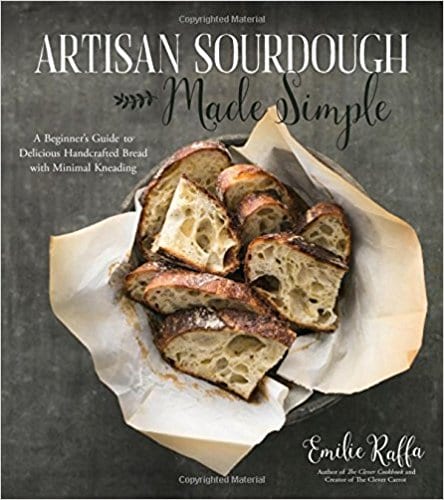


Comments
Chris says
My husband wanted a lasagna for his birthday and this one hit the spot! I ended up using double the amount meat for the ragu. I adjusted to 75% milk and used just one can of San Marzano tomatoes. The pasta turned out perfect – even without a pasta rolling machine. I hand rolled the pasta as much as it would stretch then let it sit in the fridge covered for about an hour, then took it out and rolled thinner to the right consistency. Thanks for the great recipe!
Diana Rich says
I made your lasagna twice already. Each time there were rave reviews. I appreciate your step by step process. Following each step made it easy and gave me the confidence to make becemella sauce which I was always fearful of making for one reason or another.
Thank you. I look forward to trying more of your recipes.
Diana
Emilie Raffa says
Diana, this is such great feedback thank you for taking the time to comment! I’m really glad you found the step-by-step instructions helpful. Understanding each component is the only way to tackle it, especially the béchamel sauce. I actually love that you can freeze béchamel… such a great time saving tip!
Rosalie M says
This looked so good I just had to try this especially since I made your bolognese sauce. First time with béchamel sauce. Have always been from the ricotta cheese camp. I plan on getting a pasta attachment for my kitchen aid to start making my own pasta sheets but decided to try this with ‘regular’ store bought lasagna. Your sheets look thinner, but this still tasted EXCELLENT! Appreciated you recommending doing this in stages..
Emilie Raffa says
Same! I grew up on ricotta lasagna, which is also good, just different. And yes: store bought lasagna sheets are totally fine to use. Very convenient too! You can even stack the sheets and cut them into tagliatelle pasta ;)
Happie says
Oh my, this just looks and sounds absolutely divine!!
What a fantastic step-by-step tutorial, I don’t even think my kids can mess this one up haha!
Looking very much forward to doing this as a yummy Fall family weekend dinner – thank you!
Emilie Raffa says
Ahh thank you so much! Kids will definitely have a lot of fun with this one, especially because it’s messy. And messy is cool ;) I hope you enjoy xx